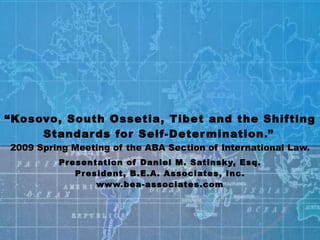
Kosovo, S. Ossetia and Tibet-Standards for Independence
- 1. “Kosovo, South Ossetia, Tibet and the Shifting Standar ds for Self-Deter mination.” 2009 Spring Meeting of the ABA Section of International Law. Pr esentation of Daniel M. Satinsk y, Esq. Pr esident, B .E.A. Associates, Inc. www.bea-associates.com
- 2. Intro and Disclaimer • I would like to thank the organizers for the opportunity to present the Russian perspective on the independence of S. Ossetia. Disclaimer is that I do not represent the Government of the Russian Federation in either official or unofficial capacity. • As a late addition, I did not contribute materials and unfortunately the historical materials and documentary materials characterize events and legal principles in way that is inherently against the Russian position. • Given the time limitations, I will focus primarily on the legal basis of the Russian position, with factual support as necessary and cognizant of the fact that each side has its own “truth” in this dispute.
- 3. Russian Recognition of S. Ossetia and Abkhazia – August 26, 2008 • Stated Legal Basis for Recognizing Independence from the Statement of the Ministry of Foreign Affairs of the Russian Federation, August 26, 2008: • Charter of the United Nations • Helsinki Final Act • 1970 Declaration of Principles of International Law Concerning Friendly Relations Among States. • Kosovo Precedent
- 4. Standards to Judge Russian Recognition • Legal Principles to Apply – Primarily Helsinki Accords as further codification of UN Charter. • Helsinki Accords are summarized in 10 Principles Guiding Relations between Participating States. Each of the 10 points is of equal weight with none controlling. This sets the stage for somewhat conflicting principles within the Helsinki Accords. This therefore requires a review of the objectives of the Accords in order to decide the question before us.
- 5. Helsinki Accords – Key Principles for Analysis of the Conflict in the Caucasus. • Sovereign equality • Refraining from the threat or use of force • Inviolability of frontiers • Territorial integrity of States • Peaceful settlement of disputes • Non-intervention in internal affairs • Respect for human rights and fundamental freedoms • Equal rights and self-determination of peoples
- 6. Helsinki Accords - Product of Cold War Era, Now Forced to Serve Post Cold War World • Accords were the product of over 100 years of worldwide warfare over political and economic control of physical territories (boundaries) – encompassing the age of European imperialism and two world wars. • Established the rules of the game for Cold War period in which the world was split between capitalist and socialist camps and was undergoing the process of national liberation/decolonialization. • Represents a set of compromises from that time which more or less successfully managed relations by emphasizing preserving existing borders. • Break up of Soviet Union and Federal Republic of Yugoslavia forced a process of re-drawing of borders that is not yet complete and has posed new and different problems to be solved by old principles.
- 7. Overview of Current Political Boundaries in the Caucasus as a Legacy of the Soviet Union • 1921 Georgia incorporated as Soviet Socialist Republic in Soviet Union • South Ossetian Autonomous Oblast (Region) was formed as part of the Georgian Soviet Socialist Republic on April 20, 1922 • In 1931, Abkhazia was made an Autonomous Republic within the Georgian Soviet Socialist Republic. • Geographic accommodations of the complex mixture of ethnic and linguistic groups within the region on boundaries established under Stalin as a political arrangement to accommodate ethnic diversity and prevent ethnic conflict.
- 8. Soviet/Post-Soviet Dissolution of Political Compromise on All Sides • 1989, April. Nationalist demonstration in Tblisi violently smashed by Soviet troops. • 1989 S. Ossetia announces intention to succeed from Georgia • 1990 March. Georgian Supreme Soviet annuls autonomy of S. Ossetia • 1991, April 9. Georgian parliament declares independence from Soviet Union. • 1991, May 26. Zviad Gamsukhurdia elected President on slogan “Georgia for the Georgians” • 1992, Referendum held in S. Ossetia in which majority voted for independence and accession to Russia, shortly thereafter S. Ossetia declared independence. • 1992, Abhazian declaration of independence from Georgia. • Resulting in armed conflicts Georgia-Ossetia (1990 -92) and Georgia-Abkhazia (1992-93) with large scale loss of life and ethnic cleansing on all sides. • Russian peace-keeping missions in both Abkhazia and S. Ossetia result in frozen conflicts punctuated by outbursts of scattered fighting from 1994 - 2008. Abkhazia – UN-mandated peacekeeping force – primarily Russians. S. Ossetia – 4 party peace mechanism through Joint Peacekeeping Force and Joint Control Commission. OSCE mission there since 1992 and EC has been observer since 1999. • August 7, 2008, Georgia bombarded Tskhinval, capital of S. Ossetia and on August 8 Georgian military forces and tanks launched an assault on Southern Ossetia, opposed by 200 Russian peacekeepers and S. Ossetia irregulars. Russians reply with air assault and on August 10 regular Russian army enters the conflict. This ended the period of the frozen conflicts and showed Georgian determination to settle the disputes by force.
- 9. Conclusions and Case for Independence under Helsinki Principles • Georgia claims Soviet-era borders for itself, but denies existence of Soviet-era borders for S. Ossetia and Abkhazia, thus the issue of territorial integrity is ambiguous with valid claims on all sides. • S. Ossetians and Abkhaz clearly have asserted their rights under the principle of self-determination and desire independence from a Georgian state. • By its actions in August 2008, Georgia has rejected the Helsinki principal of peaceful settlement of disputes. • Russians apply the Kosovo precedent and recognize independence based on the particulars as the only means of bringing stability and ethnic peace within the area.
